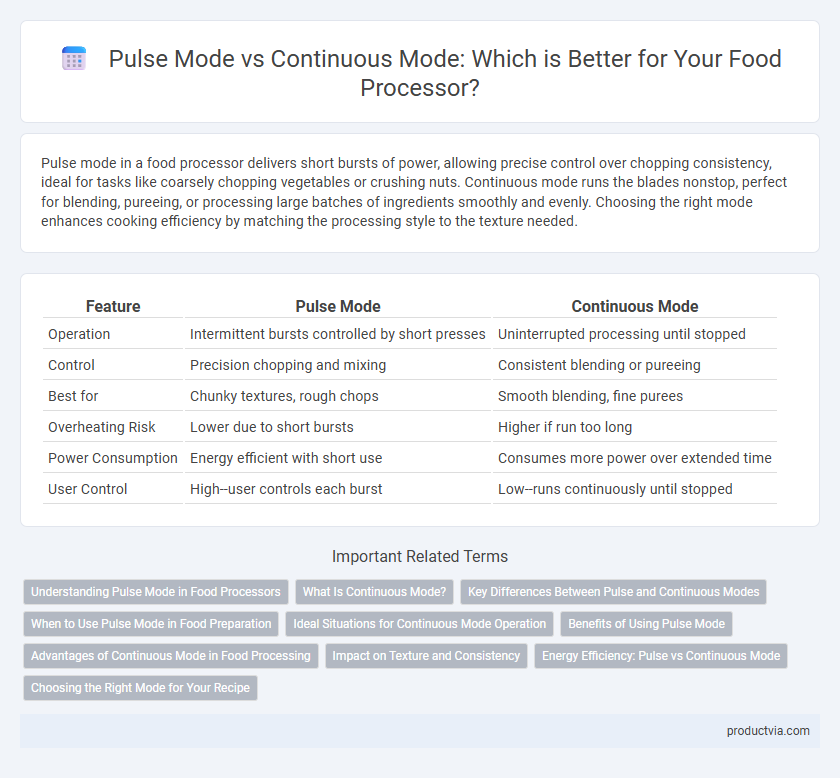Pulse mode in a food processor delivers short bursts of power, allowing precise control over chopping consistency, ideal for tasks like coarsely chopping vegetables or crushing nuts. Continuous mode runs the blades nonstop, perfect for blending, pureeing, or processing large batches of ingredients smoothly and evenly. Choosing the right mode enhances cooking efficiency by matching the processing style to the texture needed.
Table of Comparison
| Feature | Pulse Mode | Continuous Mode |
|---|---|---|
| Operation | Intermittent bursts controlled by short presses | Uninterrupted processing until stopped |
| Control | Precision chopping and mixing | Consistent blending or pureeing |
| Best for | Chunky textures, rough chops | Smooth blending, fine purees |
| Overheating Risk | Lower due to short bursts | Higher if run too long |
| Power Consumption | Energy efficient with short use | Consumes more power over extended time |
| User Control | High--user controls each burst | Low--runs continuously until stopped |
Understanding Pulse Mode in Food Processors
Pulse mode in food processors allows precise control over chopping and blending by operating the motor in short bursts, preventing over-processing and preserving texture. This mode is ideal for tasks like chopping nuts, herbs, or making chunky salsas, where maintaining ingredient integrity is crucial. Unlike continuous mode, pulse mode minimizes heat buildup, reducing the risk of food oxidation and maintaining flavor quality.
What Is Continuous Mode?
Continuous mode in a food processor operates the blades nonstop at a consistent speed, ideal for processing large quantities of ingredients efficiently and creating smooth textures like purees or dough. This setting allows the motor to run until manually stopped, providing uniform chopping, blending, or mixing without interruption. Users rely on continuous mode for tasks requiring prolonged blending time, ensuring thorough and even processing of ingredients.
Key Differences Between Pulse and Continuous Modes
Pulse mode in a food processor offers precise control by delivering short bursts of power, ideal for tasks requiring coarse or uneven chopping such as making salsa or chunky pesto. Continuous mode provides a steady, uninterrupted operation suited for thorough blending and pureeing, making it perfect for smooth soups or dough preparation. Key differences include the level of control and texture outcome, with pulse mode preserving texture and continuous mode achieving uniform consistency.
When to Use Pulse Mode in Food Preparation
Pulse mode in a food processor is ideal for precise control when chopping vegetables, nuts, or herbs to achieve a coarse or uneven texture without over-processing. It operates in short bursts, allowing you to monitor consistency and prevent turning ingredients into a puree. Use pulse mode when you need to maintain texture or when working with delicate ingredients that require careful handling.
Ideal Situations for Continuous Mode Operation
Continuous mode operation in a food processor is ideal for processing large quantities of ingredients quickly and evenly, such as when making dough or pureeing soups. This mode maintains a steady blade rotation, ensuring thorough mixing of dense or uniform textures without interruption. Using continuous mode is especially efficient for tasks requiring consistent processing time and smooth, homogeneous results.
Benefits of Using Pulse Mode
Pulse mode on a food processor offers precise control over chopping and mixing, preventing over-processing and ensuring optimal texture. This mode allows short bursts of power, ideal for tasks like coarse chopping, blending chunky salsas, or incorporating ingredients without turning them into puree. Using pulse mode enhances the versatility of the food processor by maintaining ingredient integrity and achieving consistent results.
Advantages of Continuous Mode in Food Processing
Continuous mode in food processors enables consistent and uniform chopping, blending, or pureeing by maintaining a steady motor speed, which ensures smoother textures and efficient processing of large quantities. It minimizes manual intervention, reducing preparation time and effort, making it ideal for recipes requiring sustained blending or thorough mixing. Continuous mode also enhances versatility, allowing users to achieve precise consistencies necessary for sauces, doughs, and emulsions without interruptions.
Impact on Texture and Consistency
Pulse mode in a food processor provides precise control over chopping and blending, allowing for coarse and uneven textures ideal for salsas or chunky mixtures. Continuous mode delivers consistent and smooth results by running the blades non-stop, perfect for purees or finely processed dough. Choosing the appropriate mode directly impacts the final texture and consistency of ingredients, influencing culinary outcomes significantly.
Energy Efficiency: Pulse vs Continuous Mode
Pulse mode in a food processor conserves energy by operating in short bursts, allowing precise control over processing time and preventing overuse of power. Continuous mode consumes more electricity by running nonstop until manually stopped, which can lead to higher energy consumption during extended use. Choosing pulse mode enhances energy efficiency by minimizing unnecessary motor operation and reducing overall electricity usage.
Choosing the Right Mode for Your Recipe
Pulse mode offers precise control for chopping, mixing, or blending ingredients in short bursts, preventing over-processing and maintaining texture in recipes like salsas and chunky dips. Continuous mode provides consistent, thorough blending ideal for purees, doughs, and smoothies where uniform texture is essential. Selecting pulse mode enhances texture control, while continuous mode ensures smooth, evenly processed results depending on your dish requirements.
Pulse mode vs Continuous mode for food processor Infographic

 productvia.com
productvia.com